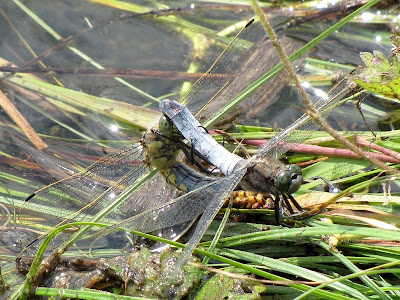I received an exciting e-mail yesterday ( well I found it exciting). A visiting 'butterfly enthusiast' had discovered not one but two
Small Blue sites on our local patch!
Small Blue is a very scarce species in Devon with only two other known sites. I've never seen a
Small Blue so was very keen to get out there and find them straight away! Unfortunately though it was cloudy and rather cool for most of yesterday so I had to wait until late this morning. My first port of call was the undercliff between Beer and Branscombe. I had been given directions to the exact spot where three were seen on Friday, I arrived a little bit early though, (too keen you see) and it was still a bit too cool, I had to wait for about fifteen minutes before I spotted any. There were three again today, two males and a female ( I think), although all three were pretty worn. Tiny little things they are, very delicate yet somehow 'robust' too, in their own kind of way. They posed beautifully for photos too!
After lunch I ventured the 400metres or so from my house to the other site, along the landslips below Haven Cliff. I'm surprised any butterflies were on the wing at all along here because this afternoon it was a very popular venue for beach barbecues with their noxious firelighter, then burnt sausage fumes wafting over the vegetation. Butterflies could be located though by carefully listening for their distinctive coughs! Just a single male Small Blue was located here, it was being constantly harassed by a couple of Common Blues. Bullies!
Female has completely brown uppersides.
Undersides of both sexes are silvery grey giving a blue appearance in flight.
With my finger and thumb for size comparison.
Gratuitous 'artistic' shot.
The Haven Cliff one was in a patch of the larval food plant Kidney Vetch.
The very slight dusting of blue scales on this one make it a male.
Here's a 'small' selection of bits and bobs I've been photographing over the last couple of days and haven't had time to put on here. If they prove too boring for you, feel free to scroll down through them to another bit of exciting news at the end of this post (which may or may not actually be exciting).
First Painted Lady of the year for me.
Burnet Companion (day flying moth)
Common Lizard
Common Spotted Orchids
The 'rather uncommon' pure white albiflora variety of Common Spotted Orchid
Quaking Grass.
As a one time student of palaeontology I can't help thinking of Trilobites when I see the flowers in close up.
The Longhorn Beetle Leptura lividia
Okay, okay, that's enough of that. What about the exciting news? Well for the last week Bun's been away in some far flung land, where no doubt he's having to endure endless tedious views of uninspiring dross such as Red flanked Bluetail, Siberian Rubythroat and Azure Tit in breeding plumage!! (Jealous? Moi?) This means that I get to use the moth trap in my 'garden' and what a success it's been! My highest catch was six moths (whoopy do!) including this beauty.
Eyed Hawkmoth.
We've caught several of these over at Bun's but I've never managed a decent photo of one before.
Amazing colour!
This female was very docile allowing me to take some real close up shots.
I think she was pretty worn out from egg laying. She left me a little something to remember her by...
I'm going to try and keep these until they become adult moths.
A decision I may well live to regret when I'm having to find fresh willow leaves for the voracious' little' caterpillars! Wish me luck! (though that's not an order).


























































